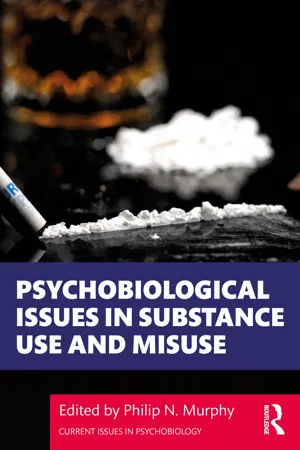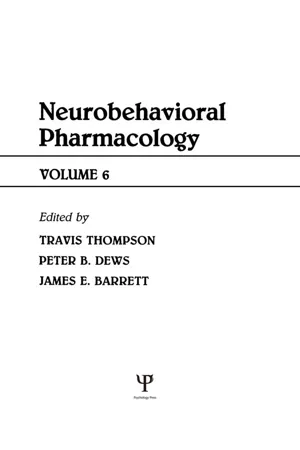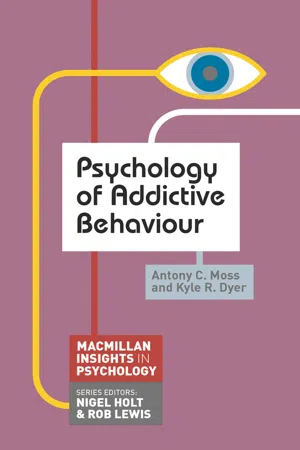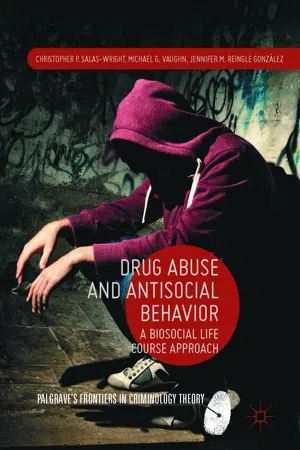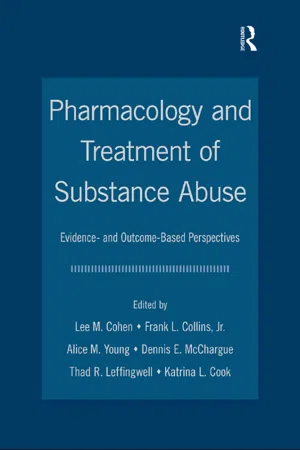Psychology
Biological Influences on Drug Use
Biological influences on drug use refer to the impact of genetic, neurological, and physiological factors on an individual's susceptibility to drug use and addiction. These influences can include genetic predispositions, brain chemistry, and the body's response to drugs, all of which play a significant role in shaping an individual's likelihood of engaging in drug use and developing substance abuse disorders.
Written by Perlego with AI-assistance
Related key terms
Related key terms
1 of 4
Related key terms
1 of 3
8 Key excerpts on "Biological Influences on Drug Use"
- Philip Murphy, Philip N. Murphy(Authors)
- 2020(Publication Date)
- Routledge(Publisher)
A considerable overlap with the subject matter of psychopharmacology is to be noted here with regard to pharmacokinetic and pharmacodynamic processes. As such processes may be regarded in a broad sense as biological, with their consequences for drug action having effects on psychological functioning (i.e. on cognitions and behavioural responses), it is difficult and artificial to separate them from a discussion of a psychobiological perspective on substance use. The term ‘social psychology’ will be used to refer to the study of psychological phenomena in relation to social influences. One commonly accepted definition of social psychology describes it as “the scientific study of the ways that people’s behaviour and mental processes are shaped by the real or imagined presence of others” [ 10 ]. From this perspective, it is these interpersonal influences which contribute to a person’s interpretation of and attribution of meaning to their behaviour. The next section of this chapter outlines some of the basic elements of psychobiological knowledge which may serve as a foundation for examining the relationship of this discipline to other domains which focus on a substance user’s subjective meanings and their interpretation of their own behaviour. Psychobiological processes in substance use and misuse The bioavailability of a drug to the brain is fundamental to its ability to influence cognition, mood, and overt behaviour. From a psychobiological perspective, two important ways in which a consumed drug may influence psychological functioning are through acting in some way on the processes of neurotransmission, and/or changing the structural properties of the brain in a way which has consequences for psychological functioning and overt behaviour- eBook - ePub
- Sandy Jackson, Luc Goossens(Authors)
- 2020(Publication Date)
- Psychology Press(Publisher)
Finally, another interesting proposal is the model by Hawkins, Catalino and Miller (1992). This model is based on the assumption that the different risk factors that configure the biopsychosocial matrix do not occur independently or in isolation but frequently take place in combination, thus affecting different areas of the adolescent’s performance. Adolescents susceptible to highrisk behaviours show problems in multiple areas and tend to belong to social networks that foster the development of these risk behaviours and reinforce their continued performance (Hawkins et al., 2002). These authors consider it necessary to study the different risk factors that are present in substance consumption from an ecological perspective, which takes into account five basic contexts: individuals, school, family, peers, and community. In this respect, they consider laws and normative behaviours, availability of substances, economic deprivation, neighbourhood disorganization and mobility to be important risk factors for substance consumption in the societycommunity context. In the family context, organization, practices of family control, conflicts, and parental styles are also considered to be relevant risk factors. In the academic area, some significant factors are recurrent absenteeism, low academic performance, little connection with the school environment and the existence of persistent and early antisocial behaviours. In relation to the peer group, Hawkins et al. (1992, 2002) regard peer rejection (or indifference at elementary school), favourable attitudes to substance consumption as well as behaviours of substance use by peers to be facilitator factors of drug consumption. Finally, in an individual context, biological and cognitive factors, rebellion against normative attitudes and values of society, lack of coping abilities, and a precocious initiation in deviant behaviours are considered by these authors to be important predictors of substance consumption.4. Applying constructs from the biopsychosocial model to initiation and continued drug useIn accordance with the main contexts (individual, family, peer group and community) proposed in the biopsychological theories just mentioned, we will now try to integrate the different concepts and constructs on which these approaches are based in an explicative model that is focused on the risk factors associated to the different phases of drug consumption.As is shown in more detail in the following, while a considerable number of these risk factors concern the individual at different levels (biological, psychological, and socio-demographical), some refer to the influences of significant others (family and peers), and some refer to elements of a macro social order.4.1 The individual: Biological psychological, and structural variables 4.1.1 Biological variablesThe studies carried out in this field have shown that various drugs that produce an increase in a positive mood or euphoria, such as nicotine and alcohol, directly or indirectly affect the inhibiting neurotransmitter GABA, dopamine in the accubems nucleus or in the prefrontal cortex (Hodgkins et al., 2004; Tomkins & Sellers, 2001). The stimulation of these dopaminergic mechanisms represents the most important factor in explaining the strengthening effects and the potential addiction of various abusive substances. In addition to dopamine, it has been confirmed that certain proteins and other neurotransmitters contribute to the pathophysiology of the individual risk of drug dependency (Smith & Capps, 2005). - eBook - ePub
Advances in Behavioral Pharmacology
Volume 6: Neurobehavioral Pharmacology
- T. Thompson, P. B. Dews, J. E. Barrett(Authors)
- 2014(Publication Date)
- Psychology Press(Publisher)
1 Ne urobiological Aspects of Drug-Seeking Behaviors Steven I. Dworkin James E. Smith Department of Psychiatry Louisiana State University Medical School INTRODUCTION Are Investigations of Neurobiological Substrates of Drug Effects Meaningful?Behavioral pharmacology is a synthesis of two disciplines: neuropharmacology and behavior analysis. Thus, many of the methods and procedures that are used originated from these two experimental approaches. The experimental analysis of behavior has contributed procedures for the precise control of an organism’s behavior that have resulted in a substantial knowledge of the behavioral determinants of drug effects. Neuropharmacologists have used biochemical and physiological methodologies to investigate the molecular mechanisms of drug action on the nervous system. These neuropharmacological techniques produced information about drug effects at both the molecular and cellular level but have not resulted in major advances in understanding basic neurobiological mechanisms of the effects of drugs on behavior (Cooper, Bloom, & Roth, 1982).The complexity of the factors that determine the effects a substance will exert on behavior is just beginning to be understood. One of the initial contributions of behavioral pharmacology was the demonstration that ongoing behavior can modify drug effects (Dews, 1958). Recent studies have shown that many factors contribute to the effects that a drug will exert on behavior. These include the ongoing rate of responding at the time the drug is administered (for review, see Dews & Wenger, 1977; McKearney & Barrett, 1978), the environmental event maintaining and/or suppressing responding (for review, see Barrett & Katz, 1981), and the behavioral (Barrett, 1977; McKearney, 1979) and drug history of the organism (i.e., drug tolerance and dependence, for review see Corfield- Sumner and Stolerman, 1978). Combinations of these variables increase the difficulty of the analysis of behavioral drug effects. - eBook - ePub
- David M. Warburton(Author)
- 2023(Publication Date)
- CRC Press(Publisher)
10DRUG ADDICTION AS A PSYCHOBIOLOGICAL PROCESSMichael A. Bozarth DOI: 10.4324/9781003420170-10INTRODUCTION
This chapter addresses the etiology of drug “addiction”. The emphasis is on biological mechanisms underlying “addiction”, although some other factors influencing drug use will also be discussed. The presentation is limited primarily to psychomotor stimulants (e.g. amphetamine, cocaine) and opiates (e.g. heroin, morphine) for two reasons. First, considerable knowledge has been gained during the past 15 years regarding the neurobiological mechanisms mediating their use. Second, these two pharmacological classes represent the best examples of potent addictive drugs, and the elucidation of their “addiction potential” can provide a framework for understanding use and abuse to other psychotropic agents.Some psychologists and sociologists assert that animal studies do not model the important psychological variables governing drug use. They suggest that psychological processes critical in the etiology of use cannot be studied in animal models and/or that environmental influences important in producing use cannot be duplicated in animal studies. This position is generally untenable, and animal models have been developed that accurately represent the primary processes involved in drug “addiction”. Support for the validity of these animal models will emanate from an understanding of the characteristics and the neural basis of drug use summarized in the following sections. The arguments presented in the chapter are tenable, but they represent only one of several perspectives used in studying substance use. The terminology and even some aspects of the empirical data are the topics of scientific debate. The objective of this chapter is not to provide a balanced presentation of controversial issues, but rather to develop a unifying framework for understanding the psychobiological basis of “addiction”. - eBook - ePub
- Antony C. Moss, Kyle R. Dyer(Authors)
- 2010(Publication Date)
- Bloomsbury Academic(Publisher)
Chapter 2The biology of addictive behaviour
Introduction
Many addictive behaviours involve the administration of drugs such as alcohol, nicotine, heroin or cocaine. The effects of these so-called drugs of dependence have been studied extensively and we know much about the biological effects of these drugs on the body and brain. The brain is a complex organ that strives for balance, and whenever we introduce a drug to the brain we upset that balance. The brain will seek to adapt to redress this imbalance, by minimizing the effects of the drug. Furthermore, addictive behaviours that do not involve the administration of drugs still involve the release of endogenous chemicals (neurotransmitters) in the reward pathway . This in itself causes an imbalance which the brain will seek to counter. Understanding these processes is key to understanding addictive behaviour.In this chapter, we will examine:The various ways in which drugs can enter the bodyThe effects of a range of drugs of dependence on the brainThe biological basis of drug tolerance and withdrawalThe role of endogenous neurotransmitters in the development of dependenceHistory shows us that people have used and abused drugs since the earliest recorded times. Indeed, it would be hard to find any civilization throughout history that did not experiment with, use or abuse drugs which can cause dependence. The primary reason for this is that drugs have a number of sought after effects, which can enhance mood, alter consciousness, improve our performance on a task, remove feelings of discomfort, and make us want to take them again. It is only in recent times that science has begun to reveal how the brain operates, and how it adapts to the presence of a drug.A drug can be defined as a chemical substance, with a known chemical structure that produces a biological and psychological effect when it is administered. Drugs can be obtained from plants or animals, they can be entirely synthetic or they may be the result of genetic engineering. The key factor is that to be a drug, it needs to be something that is administered to the body rather than a natural (endogenous) substance released by the body. - eBook - ePub
Drug Abuse and Antisocial Behavior
A Biosocial Life Course Approach
- Christopher P. Salas-Wright, Michael G. Vaughn, Jennifer M. Reingle González(Authors)
- 2017(Publication Date)
- Palgrave Macmillan(Publisher)
In short, addiction is a biosocial process. Perhaps a stronger criticism is that the biology of addiction will lead to pharmaceutical solutions that trade one pill for another. While one could argue that this trade results in ultimately less harm, it is still less than ideal. With respect to problem behavior there have been empirical studies of the classic tradeoff between heroin and methadone maintenance. Research on methadone maintenance suggests the benefits are indeed favorable. For example a meta-analysis conducted on the outcomes of opiate use, HIV transmission risk, and criminality found that methadone maintenance resulted in consistent statistically significant reduction in these behaviors (Marsch 1998). Another criticism, made for example by Hall et al. (2015a), is that the brain disease model has yet to deliver on its potential or promises. One of their major criticisms is that the emphasis on brain-related technologies and costly treatment that stem from the brain disease model is simply not affordable or cost-effective for most addicted persons. Moreover, the scientific returns have been modest in advancing our understanding of addiction. The concern is that the bells and whistles of neuroscience have led to an inordinate focus on the brain and, more specifically, on the brains of severely addicted individuals, with little gained. Volkow and Koob (2015) disagree, suggesting that tremendous strides in understanding the neural basis of addiction have been made across animal and imaging models. There are two implications from these critiques that we think require separation. First, uncovering the neuroscientific basis of addiction is a worthy goal and we support and partially build our approach on continued basic research in this vein. We agree that there is a tendency to overemphasize the genetic and neurobiological understanding of addiction (not to mention research funding) without adequate integration of environmental and life-course factors - eBook - ePub
Alcohol, Other Drugs, and Behavior
Psychological Research Perspectives
- John R. Jung(Author)
- 2009(Publication Date)
- SAGE Publications, Inc(Publisher)
CHAPTER 5Neurobiology of Alcohol and Other Drug Use
What Happens After Drugs Are Taken? How Drugs Affect the Nervous System How Neurons Communicate How Alcohol and Other Drugs Affect Neurotransmission Changes in Neurophysiology With Prolonged Drug Use Neuroadaptational Models Physical Effects of Drugs A Safe Level of Alcohol Use? Summary Stimulus/ResponseDown among his nerve-cells and fibres the molecules are counting it, registering and storing it up to be used against him when the next temptation comes .—William James, Principles of Psychology (1890), p. 127P eople get alcohol and other drugs into their bodies through a variety of means. Whereas they swallow or sip alcoholic beverages, they typically smoke tobacco and marijuana, although some may also chew smokeless tobacco. Heroin is typically injected directly into veins while cocaine is commonly snorted, sniffed, or smoked. The specific method by which drugs are consumed is an important determinant of how rapidly specific drugs reach the brain. Eventually, drugs are detoxified by metabolic processes or eliminated from the body as waste material. Pharmacokinetics refers to how drugs enter, circulate, and exit our bodies whereas pharmacodynamics deals with the physiological and biochemical effects of drugs and the mechanisms of action.Irrespective of how drugs enter the body and find their way to the brain, they affect neuro-transmission processes that determine their psychological and behavioral impact. The purpose of this chapter is to provide a basic understanding of the pharmacology and neurophysiology of psychoactive drugs. As we shall see in this chapter, however, these processes are not invariant over time. They differ for the initial, intermediate, and later episodes because continued use of alcohol and other drugs creates neurophysiological changes in brain processes (Koob & Le Moal, 2005). - eBook - ePub
Pharmacology and Treatment of Substance Abuse
Evidence and Outcome Based Perspectives
- Lee M. Cohen, Frank L. Collins, Jr., Alice Young, Dennis E. McChargue, Thad R. Leffingwell, Katrina L. Cook(Authors)
- 2013(Publication Date)
- Routledge(Publisher)
“Drug craving is the desire for the previously experienced effects of a psychoactive substance. This desire can become compelling and can increase in the presence of both internal and external cues, particularly with perceived substance availability. It is characterized by an increased likelihood of drug-seeking behavior and, in humans, drug-related thoughts” (Markou et al., 1992). Craving Type 1 • Induced by stimuli that have been paired with drug self-administration, such as environmental cues. • Termed conditioned positive reinforcement in experimental psychology. • Animal model: Cue-induced reinstatement where a cue previously paired with access to a drug reinstates responding for a lever that has been extinguished. Craving Type 2 State of protracted abstinence in drug-dependent individuals weeks after acute withdrawal. Conceptualized as a state change characterized by anxiety and dysphoria. Animal model: Residual hypersensitivity to states of stress and environmental stressors that lead to relapse to drug-seeking behavior.Passage contains an image
6 Genetics of Addiction
Lara A. Ray University of CaliforniaKent E. Hutchison University of New Mexico and Mind Research NetworkBehavioral Genetics of Addiction
Behavioral genetics is the field of study that seeks to understand both the genetic and environmental contributions to individual variation in human behavior. In order to accomplish such a challenging task, a number of research strategies are often employed, such as family, twin, and adoption studies designed to parse out the biological from environmental influences on a given behavior. More recently, genetic linkage and association studies have been used to identify location for genes associated with a given disorder and specific genes underlying the disorder, respectively. Genetics and molecular biology methods have developed rapidly and have provided important insight into the mechanisms by which genes may come to influence human behavior. The first step in studying behavioral genetics is to determine that the behavior, or in this case, psychiatric disorder of interest, is indeed substantially influenced by genetics. In order to determine the relative contribution of genetic and environmental factors to a given psychiatric disorder, behavioral geneticists traditionally rely on three basic strategies: family, twin, and adoption studies.
Index pages curate the most relevant extracts from our library of academic textbooks. They’ve been created using an in-house natural language model (NLM), each adding context and meaning to key research topics.
Explore more topic indexes
Explore more topic indexes
1 of 6
Explore more topic indexes
1 of 4
